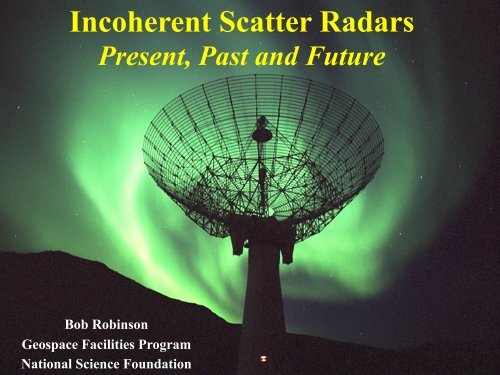Incoherent scatter radars: present, past and future
Incoherent scatter radars: present, past and future
Incoherent scatter radars: present, past and future
You also want an ePaper? Increase the reach of your titles
YUMPU automatically turns print PDFs into web optimized ePapers that Google loves.
<strong>Incoherent</strong> Scatter Radars<br />
Present, Past <strong>and</strong> Future<br />
Bob Robinson<br />
Geospace Facilities Program<br />
National Science Foundation
3. It is difficult to imagine an area of space science research that<br />
does not benefit from the data provided by the incoherent<br />
<strong>scatter</strong> <strong>radars</strong>.<br />
2. Because the incoherent <strong>scatter</strong> <strong>radars</strong> are able to measure height<br />
profiles of the most fundamental ionospheric properties, data from<br />
these instruments are used for a broad range of research studies<br />
pertaining to the upper atmosphere, ionosphere, <strong>and</strong><br />
magnetosphere.<br />
1. The Geospace Facilities (GF) Program in the Division of<br />
Atmospheric <strong>and</strong> Geospace Sciences at the National Science<br />
Foundation (NSF) was created in 1983 to oversee the scientific<br />
operation of a network of incoherent <strong>scatter</strong> <strong>radars</strong> used to probe<br />
the upper atmosphere <strong>and</strong> ionosphere.<br />
Geospace Facilities Program
NSF Hierarchy<br />
Barack<br />
Obama<br />
NSF<br />
Director<br />
Computer<br />
Sciences<br />
Education<br />
<strong>and</strong> Human<br />
Resources<br />
Social,<br />
Behavioral <strong>and</strong><br />
Economic<br />
Sciences<br />
Engineering<br />
Math <strong>and</strong> Physical<br />
Sciences<br />
Geosciences<br />
Biological<br />
Sciences<br />
Ocean<br />
Sciences<br />
Atmospheric <strong>and</strong><br />
Geospace Sciences<br />
Earth Sciences<br />
Atmospheric Section<br />
Geospace Section<br />
NCAR <strong>and</strong><br />
Facilities Section<br />
Solar Physics<br />
Magnetosheric<br />
Physcis<br />
Geospace<br />
Facilities<br />
Aeronomy
Goals of the GF Program<br />
• To ensure that the science undertaken at the GF-sponsored<br />
facilities is of the highest quality <strong>and</strong> is coordinated with the<br />
university community to produce a synergistic effect in the<br />
advancement of upper atmospheric science; <strong>and</strong><br />
• To ensure that the facilities are maintained as state-of-the-art,<br />
cost-effective research tools available to all qualified scientists,<br />
<strong>and</strong> that the data <strong>and</strong> services provided by the facilities are<br />
adequate to meet the communitys short- <strong>and</strong> long-range<br />
scientific objectives;<br />
• To educate the next generation of space scientists in the<br />
development, operation, <strong>and</strong> use of multi-user facilities, leading<br />
to the maintenance of a diverse, highly-qualified user base for<br />
upper atmospheric research data.
The NSF <strong>Incoherent</strong> NSF-supported Scatter ISRs--2011<br />
Radar Chain-2006<br />
Chain-2007<br />
AMISR- Resolute<br />
Bay (RISR)<br />
AMISR-<br />
Poker Flat<br />
PFR<br />
PFISR<br />
2007<br />
2007<br />
MH<br />
1962<br />
RISR<br />
2008<br />
SRF<br />
1982<br />
1982<br />
Sondrestrom (SRF)<br />
AMISR-<br />
Poker Flat<br />
Jicamarca (PFISR)<br />
(JRO)<br />
AO<br />
1962<br />
JRO<br />
1963<br />
Millstone<br />
Millstone Hill<br />
Hill (MH)<br />
(MH)<br />
Jicamarca (JRO)<br />
Arecibo (AO)
A timeline of incoherent events<br />
Bill Millstone Gordon Jicamarca Arecibo DNA built builds NSF Stanford takes NSF support NSF takes NSF EISCAT takes Chatanika EISCAT<br />
conceives by MIT built Lincoln of built by ISR by at over Arecibo radar of Millstone over over UHF Radar radar moved VHF radar<br />
incoherent Lab NBS DARPA Stanford from moved DoD Hill to Radar Chatanika Jicamarca to built Greenl<strong>and</strong> Built<br />
<strong>scatter</strong><br />
Chatanika begins from from DNA NOAA<br />
EISCAT<br />
Svalbard<br />
Radar built<br />
AMISR AMISR is is<br />
built built in in<br />
Alaska Canada<br />
1955 1960 1965 1970 1975 1980 1985 1990 1995 2000 2005 2010
ISR Starts <strong>and</strong> Stops<br />
• France: St. Santin, (multistatic)<br />
1963-1987<br />
• UK: Malvern, (multi-static)<br />
1968-1975<br />
• MISCAT, Aberystwyth, UK,<br />
1972 (multi-static--first ISR to<br />
measure three-dimensional drift<br />
velocities)<br />
• The Upper Atmosphere<br />
Observatory (U. S.), planned<br />
1969-1975<br />
• The Polar Cap Observatory<br />
(Canada), planned 1987-1997
ISR Deployment Strategies<br />
• Global coverage<br />
for the <strong>future</strong><br />
• Ease <strong>and</strong> cost-effectiveness in ISR<br />
operation<br />
• Interoperability <strong>and</strong> commonality in ISR<br />
scheduling, operating modes, <strong>and</strong> data<br />
access<br />
• Global leveraging <strong>and</strong> coordination
How do we know how many<br />
observatories are enough?<br />
Knowledge of System<br />
100<br />
90<br />
80<br />
70<br />
60<br />
50<br />
40<br />
30<br />
20<br />
10<br />
0<br />
0 2 4 6 8 10 12<br />
Number of Observing Sites
Where do we need ISRs?<br />
• Within the polar cap (Resolute Bay)<br />
• Around the auroral oval (Poker Flat,<br />
Sondrestrom, Tromso, Svalbard)<br />
• Sub-auroral zone (none)<br />
• Mid-latitude (Millstone, Kharkov)<br />
• Low latitude (Arecibo)<br />
• Equator (Jicamarca+one more)<br />
• Low latitude southern hemisphere (Argentina)<br />
• Auroral latitude southern hemisphere (McMurdo)
Meridian Ring of AMISRs
ISR Global Operating Modes<br />
Northern<br />
Hemisphere<br />
Science Mode<br />
Southern<br />
Hemisphere<br />
Science Mode<br />
Conjugate<br />
Science Mode<br />
Equatorial<br />
Science Mode<br />
Meridional<br />
Science Mode<br />
Auroral<br />
Science Mode<br />
Resolute-N 128 64 64<br />
Resolute-S 64 128 64 128 64<br />
Sondrestrom<br />
EISCAT Svalbard<br />
Other Canada 64 64 64 128<br />
Poker Flat 128 96<br />
EISCAT Tromso<br />
Millstone<br />
Arecibo<br />
Jicamarca 7 7 7 32 7 7<br />
Brazil 32 128 32<br />
La Plata 16 64 32 128 64 16<br />
Antarctic Peninsula 64 96 64 64<br />
Antarctic Auroral 64 96<br />
McMurdo 64 96 64<br />
Total Panels 407 423 423 416 423 407
The NSF <strong>Incoherent</strong> Scatter Radar Chain-2007 <br />
What is the OR: <strong>future</strong> of ISR?<br />
grow<br />
• The existing chain of <strong>radars</strong> with the will ability to continue run routinely for to<br />
many hours<br />
grow with the blossoming of AMISR<br />
RBR <br />
PFR <br />
systems<br />
PFR <br />
at other locations.<br />
2008 <br />
Sondrestrom (SRF) <br />
200<br />
advanced radiowave <strong>and</strong> optical<br />
2007 <br />
AMISR-<br />
Poker Flat <br />
AO <br />
1962 <br />
MH <br />
1962 <br />
JRO <br />
Jicamarca (JRO) <br />
1963 <br />
SRF <br />
1982 <br />
7 <br />
AO <br />
1962 <br />
JRO <br />
1963 <br />
MH <br />
1962 <br />
SRF <br />
1982 <br />
1982 <br />
• The global chain of ISRs will continue to<br />
• ISRs of the <strong>future</strong> will be lower cost,<br />
• Each ISR site will include a cluster of<br />
instrumentation for comprehensive<br />
observations of the upper atmosphere<br />
• The ISR network will be fully<br />
integrated, with smart, interactive,<br />
autonomous operation<br />
• Barriers between ISRs will disappear,<br />
Millstone Hill (MH) <br />
allowing users <strong>and</strong> students greater<br />
versatility, flexibility <strong>and</strong> ease in<br />
conducting experiments<br />
• Most importantly, the next generation of<br />
radar users will be knowledgeable <strong>and</strong><br />
skilled in all aspects of ISR operation<br />
<strong>and</strong> data analysis, leading to new<br />
discoveries <strong>and</strong> improved Arecibo (AO) capabilities
Question<br />
• What is the most important aspect of incoherent<br />
<strong>scatter</strong> <strong>radars</strong> that have kept them at the forefront<br />
of ionospheric <strong>and</strong> atmospheric research?<br />
???
















